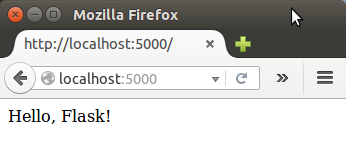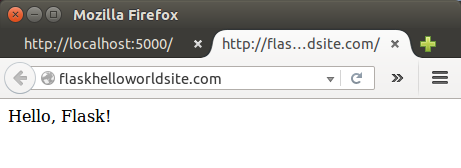Flask Hello World App with Apache WSGI

Flask is a fantastic micro web framework for Python, however, it is not a native web language. So to get our Python code running on a web server is tricky.
Apache will use WSGI file to access our Flask application, so the WSGI file allows Apache to interact with Python as if it is native. It's a simple script.
In this article, we'll start from a very simple app which just outputs "Hello, Flask!"
First, we just run it with Python interpreter. Then, we'll serve the page via Apache with WSGI.
WSGI (Web Server Gateway Interface) is an interface between web servers and web apps for python.
mod_wsgi is an Apache HTTP server module that enables Apache to serve Flask applications.
We need to use the following command to install mod_wsgi:
$ sudo apt-get install libapache2-mod-wsgi python-dev
To enable mod_wsgi, we can use the following command:
$ sudo a2enmod wsgi
THe picture below shows our application files:

The __init__.py looks like this:
from flask import Flask
app = Flask(__name__)
@app.route("/")
def hello():
return "Hello, Flask!"
if __name__ == "__main__":
app.run()
We can directly execute an app via app.run() since Flask(more specifically, Werkzeug) has an internal WSGI server for test.
Setup virtualenv:
$ sudo virtualenv venv $ source venv/bin/activate (venv)$
Install Flask:
(venv)$ sudo pip install Flask
Install Flask:
(venv)$ $ sudo python __init__.py * Running on http://127.0.0.1:5000/ (Press CTRL+C to quit)
This tells us the web server has been started and if we point our browser now to localhost:5000/ we will see the hello function is executed and the browser will display the text "Hello, Flask!"

Now we want to serve the page using Apache via WSGI which halps to get our code deployed on Apache.
Here is the Apache config file (/etc/apache2/sites-available/flaskhelloworldsite.com.conf):
<VirtualHost *:80>
ServerAdmin webmaster@flaskhelloworldsite.com
ServerName www.flaskhelloworldsite.com
ServerAlias flaskhelloworldsite.com
ErrorLog /var/www/flaskhelloworldsite.com/logs/error.log
CustomLog /var/www/flaskhelloworldsite.com/logs/access.log combined
WSGIDaemonProcess helloworldapp user=www-data group=www-data threads=5
WSGIProcessGroup helloworldapp
WSGIScriptAlias / /var/www/FLASKAPPS/helloworldapp/helloworldapp.wsgi
Alias /static/ /var/www/FLASKAPPS/helloworldapp/static
<Directory /var/www/FLASKAPPS/helloworldapp/static>
Order allow,deny
Allow from all
</Directory>
</VirtualHost>
$ sudo a2ensite flaskhelloworldsite.com.conf
The WSGI file (/var/www/FLASKAPPS/helloworldapp/helloworldapp.wsgi):
#!/usr/bin/python import sys sys.path.insert(0,"/var/www/FLASKAPPS/") from helloworldapp import app as application
Add the following line to /etc/hosts file:
127.0.0.1 flaskhelloworldsite.com
Also, we need to create /var/www/flaskhelloworldsite.com/logs directory:
$ sudo mkdir -p /var/www/flaskhelloworldsite.com/logs
Change the owner:
$ sudo chown -R www-data:www-data flaskhelloworldsite.com
Let's reload the Apache server:
$ sudo /etc/init.d/apache2 reload
Go to the browser and type in flaskhelloworldsite.com:

Ph.D. / Golden Gate Ave, San Francisco / Seoul National Univ / Carnegie Mellon / UC Berkeley / DevOps / Deep Learning / Visualization